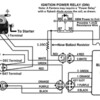The primary resistance of a Duraspark II coil is 1.17Ω. So each tenth of an ohm in the primary circuit is significant. For instance the ballast resistance in 1976 was 1.30Ω, Ford dropped the resistance to 1.10Ω in 1977 for a boost in performance (that was the only electrical change made).
When I look at that circuit I see 3 unknowns, the resistance in the 50 year old ignition switch, the resistance in the 50 year old pink wire, and the resistance in the 50 year old tach. That's why I normally have folks install a power relay as in the schematic below, to bypass the car's wiring harness entirely. But in this case we can't bypass the tach, keeping the tach operational is the owner's main concern. Panteras have a lot of problems associated with the ignition switch, but not so much Ford vehicles. So I've kept the ignition switch in the circuit too. But that leaves the ballast resistance. It was nominally 1.35Ω, which is already a bit too much, but it could have been much much more and still have been within "tolerance". After 50 years, who knows what the resistance is today. The last unknown in the equation is the human factor ... people of various skill levels are performing this work. I can't expect all of them to be capable of measuring a circuit's resistance and making a valid decision based on that measurement. I can't be there to help each of them either. All I can do is post a schematic on the internet.
The aftermarket wiring harnesses supply a new "accurate" ballast resistor ... so why not use it and hope for the best ignition performance possible? If an owner wants to get lazy and use the pink wire that's fine, but if the ignition doesn't perform as well as it should, it was due to their decision and not my instructions.
.
PANTERA INTERNATIONAL
A DE TOMASO CAR CLUB
Presents the De Tomaso Forums
The On-Line Meeting Place for De Tomaso Owners and Enthusiasts From Around the World
Clicking on the banner will take you to the sponsor's website.


